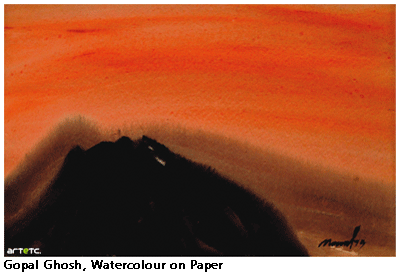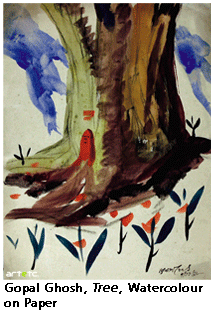- Publisher's Note
- Editorial
- Looking from the Other Side
- Women in Rabindranath Tagore's Paintings
- Ramkinkar Baij's Santhal Family
- The Birth of Freedom in Moments of Confinement
- Jamini Roy's Art in Retrospect
- The Great Journey of Shapes: Collages of Nandalal Bose
- Haripura Posters by Nandalal Bose: The Context and the Content
- The Post-1960s Scenario in the Art of Bengal
- Art Practice in and Around Kolkata
- Social Concern and Protest
- The Dangers of Deifications
- Gobardhan Ash: The Committed Artist of 1940-s
- Gopal Ghose
- Painting of Dharmanarayan Dasgupta: Social Critique through Fantasy and Satire
- Asit Mondal: Eloquence of Lines
- The Experiential and Aesthetic Works of Samindranath Majumdar
- Luke Jerram: Investigating the Acoustics of Architecture
- Miho Museum: A Structure Embedded in the Landscape
- Antique Victorian Silver
- Up to 78 Million American Dollars1 !
- Random Strokes
- Are We Looking At the Rise of Bengal
- Art Basel and the Questions it Threw Up
- What Happened and What's Forthcoming
- Art Events Kolkata, May – June 2012
- Mumbai Art Sighting
- Delhi Dias
- Art Bengaluru
- Preview June, 2012 – July, 2012
- In the News, June 2012
ART news & views
Gopal Ghose
Issue No: 30 Month: 7 Year: 2012
by Sandip Sarkar
Gopal Ghose is one of the major artists of the 20th Century Modern India. He was born on the 5th December, 1913 in Kolkata. He once told me: “I am a 19th century product. 20th century began rather late. History had to do a caesarian section to deliver the baby. The Great War that started in 1914 was the gynaecological surgeon. This explains what went before and after the event in the field of visual art. Dada and Surrealism are, as it were, miscarriage of the foetus and not the baby; if you understand what I mean!” He would sometimes speak in parables. His life was a paradox also.
One day in November 1973 I went to interview Ghose for Samar Sen's Weekly Frontier, where I was doing a series titled Artists' of West Bengal, which tried to analyze an artist in the light of his life.
 I still remember going to his house in Haripada Dutta Lane, Tollygunge. I found him waiting for me in a nearby stationary shop, squatting on his haunches and chatting with the people of the neighbourhood. As he saw me getting down from the cycle rickshaw, he stood up to take me home. He showed me his small garden which had mango, lemon and several fruit and flowering trees and a cute cactus. His personal atelier-come-bedroom was over full with furniture, books, note-books and watercolours, pastels and sketches. There were besides two unfinished canvasses done in oil on two easels. The room did not have anything of affluence in it, but there was enough proof that the artist was hard-working.
I still remember going to his house in Haripada Dutta Lane, Tollygunge. I found him waiting for me in a nearby stationary shop, squatting on his haunches and chatting with the people of the neighbourhood. As he saw me getting down from the cycle rickshaw, he stood up to take me home. He showed me his small garden which had mango, lemon and several fruit and flowering trees and a cute cactus. His personal atelier-come-bedroom was over full with furniture, books, note-books and watercolours, pastels and sketches. There were besides two unfinished canvasses done in oil on two easels. The room did not have anything of affluence in it, but there was enough proof that the artist was hard-working.
 Probably no artist in the country, during contemporary times, has loved the Indian landscape as Gopal Ghose. No one has been able to point out it's majesty and grandeur as he has. Others have leaned on tit-bits from classical and medieval times, mixed it with Far Eastern calligraphy and wash technique, hooked as they were with Pan-Asian world view. Others have gone to the opposite extreme. They have exposed their affinities to Western Academic style landscape painting, both the naturalistic and geometrical abstract type.
Probably no artist in the country, during contemporary times, has loved the Indian landscape as Gopal Ghose. No one has been able to point out it's majesty and grandeur as he has. Others have leaned on tit-bits from classical and medieval times, mixed it with Far Eastern calligraphy and wash technique, hooked as they were with Pan-Asian world view. Others have gone to the opposite extreme. They have exposed their affinities to Western Academic style landscape painting, both the naturalistic and geometrical abstract type.
His father was an army captain. Most of his childhood was spent in Shimla where his father was stationed. The next phase of his life was spent in Allahabad and Benaras where his father was transferred. After passing matriculation he enrolled in the Intermediate of Arts Course in the Anglo-Bengali College, Allahabad. He could not complete it as he joined the Civil Disobedience Movement led by Pandit Nehru. Ghose's indulgent father allowed him to join the Maharaja School of Arts, Jaipur. From the age of eighteen to twenty-two (1931- 1935), he trained rigorously in the techniques and theory on Neo- Bengal School of Art, under Vice Principal Sailendra Nath Dey. He stood 1st Class 1st. In Jaipur he was not happy with the teaching staffs' insistence on tradition and heritage. In editor Ramananda Chatterjee's twin monthlies Prabashi (Bengali) and Modern Review (English), he saw reproduction of Debi Prosad Roy Choudhury's works, his illustrations for novels and articles. Like students from other regions of undivided India, Ghose felt attracted and joined the School. Roy Choudhury was then the Principal of Government School of Art and Craft, Madras. Here Ghose also stood 1st Class 1st in painting. After passing out he toured the length and breadth of undivided India on a cycle. In 1938 he came and settled in Kolkata and wrote an illustrated travelogue in Bangashree (a Bengali monthly).
This venture paid off and he was offered an art teacher's job in the B.T. teacher's training course in Scottish Church College. He also worked as a part- time lecturer in architecture department of B.E. College, Shibpur. From 1940-45 he worked as an art teacher in Indian Society of Oriental Art. In 1951-52 he joined the Government School of Art and Craft, Kolkata. Soon after this, it became a 'College'.
“It was my father who inspired me and provided for me, even during the long years of my art school days. He sponsored my cycle tour and arranged for my stay in military cantonments throughout India.” Evidently he not only strongly identified with his father but also his feeling for him verged on adoration. Not a single word did he utter about his mother. However it seemed strange that, he an artist, did not paint a portrait of his father.
Ghose began to recount his travels abroad. He could not forget the impressions that the works of ancient and modern masters made on him. He felt, however, they could not or should not be aped, for their life-style and climate was different. The social conditions that had influenced them were dissimilar to those of India. The Indian sun was different than the sun that shone in Paris. The trees, flowers, people and rivers of the sub-continent were different. Each season was different from the seasons elsewhere in the world.
Like all artists his works remain scattered with collectors around the world. One has to browse through some of his works collected by the National Gallery of Modern Art, AIFACS and Academy of Fine Arts to get an idea of the range of his paintings.
Together with Nirode Mazumdar, Prodosh and Kamala Dasgupta, Rathin Moitra, Subho Tagore, Paritosh Sen, Prankrishna Paul, Ghose was also one of the founders of the 'Calcutta Group'. Later due to the resignation of Subho Tagore and prolonged absence of Mazumdar and Sen in France, Prodosh Dasgupta in 1950 had no other option left. He quickly included Abani Sen, Gobardhan Ash, Hemanta Mishra to keep the group and others moving. Formed during World War II and the Bengal Famine in 1943, the Group spelt out the contours of Modernism in Indian art some years before Progressive Artist Group, Bombay could project itself. Gopal Ghose was basically a romantic dreamer, a rebel in some sense, who had been unable to atune to the complexities that urbanization brings. Cut-throat competitiveness, corruption at all levels, devaluation of values, breakdown of established norms had upset him. He had gone back to nature. His approach may remind one of Wordsworth. But even if one studies a sample of his works, one makes out immediately that he is not a pantheist who believes in mechanical determination. Rather he is a Tagorean who tries to be one with nature. In art-historical terms he has imbibed the basics of modernity from Post Impressionism down to Abstract Expressionism, Indian miniatures to the landscape paintings of brothers Gaganendranath and Abanindranath. Yet he has moulded such opposites into a perfect style that is personally his own.
He quickly developed from his apprentice period in Jaipur and Madras and moved into his own domain. During the 1940s art Critic and Historian William Archer was stationed in Dumka, Bihar as a civilian administrator. His wife Ms. Margaret also an art critic and historian was with him. They invited Mazumdar and Ghose over to spend a month with them. Suddenly the dams burst and both came into their own. Later Bishnu Dey, the poet, took both to Rickhiya, Bihar. Here what they had achieved earlier came to fruition.
Ghose concentrated on landscapes and worked away on undulating hills and vales of the Chotanagpur region. The rugged fields with lonely trees, rice fields spreading to the horizon are the subject of his works during the Dumka period; In them rarely does an aboriginal woman or perhaps a cow comes into view.

Trees, birds, mountains, the sea, valleys, clouds have all attracted him and he has lovingly tried to capture nature's various moods – the light and shades of glorious glowing colours, the change of seasons, the atmosphere. His lines are aflame with the nuances of nature's beauty.
 Later in life when he travelled to America, he was not attracted to skyscrapers, city scenes or the people. It is the Rockies, the expansive prairie, the winding mighty rivers and sometimes even the lonely cactus in the sand dunes that caught his attention. He has identified with the grandeur of the vastness of North American countryside. Strangely enough, he has no comments to make about American people and the pattern of their culture.
Later in life when he travelled to America, he was not attracted to skyscrapers, city scenes or the people. It is the Rockies, the expansive prairie, the winding mighty rivers and sometimes even the lonely cactus in the sand dunes that caught his attention. He has identified with the grandeur of the vastness of North American countryside. Strangely enough, he has no comments to make about American people and the pattern of their culture.
Gopal Ghose's watercolours and pastels make it almost seem that India or even America does not have people. Most of the time he seems to have left out men and beasts. His botanical kingdom may sometimes seem to lack human warmth. Devoid of human existence, conflict and compassion, it is, in a sense a search for mystical joy. This is his strength and also his weakness.
He died on the 30th July, 1980. With his death the passé-partout of Indian landscape painting, was handed over to his younger contemporaries.